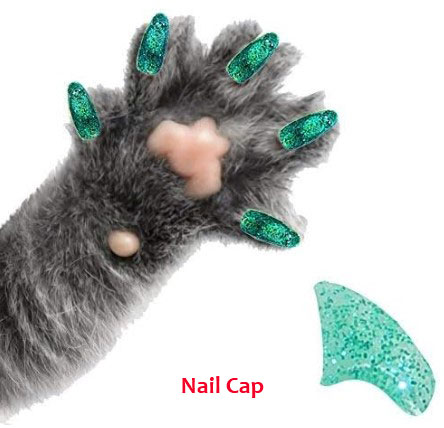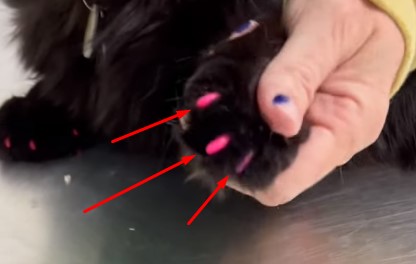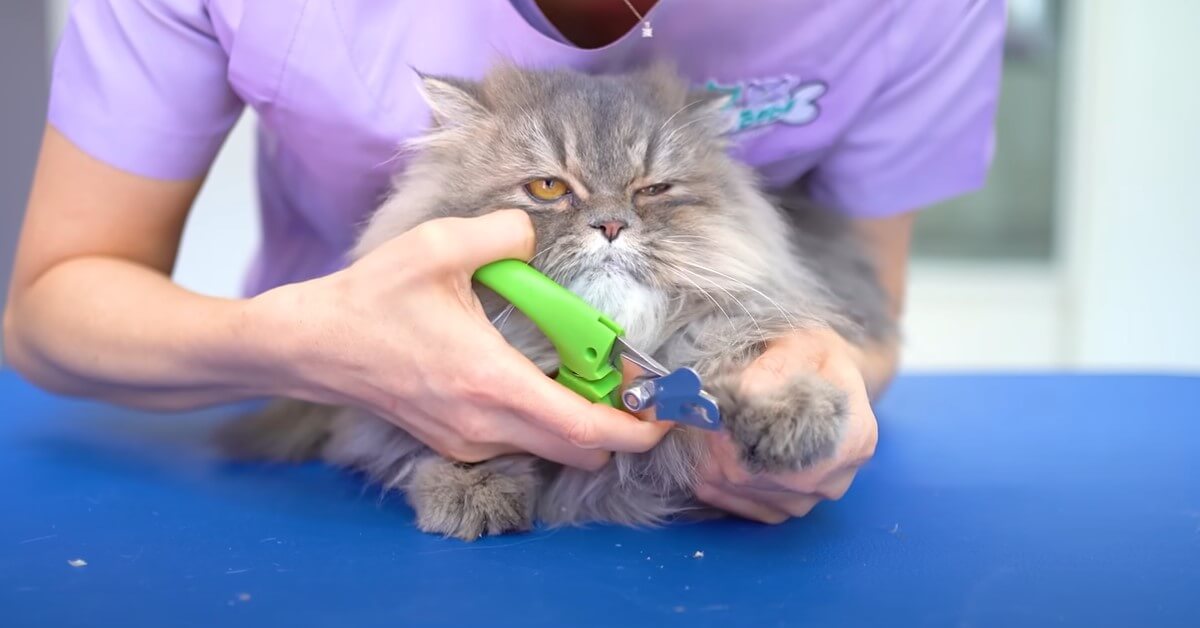Cat owners seek a balance between their feline friend’s natural instincts and a scratch-free home.
Furniture scratching by cats can be really bad, harmful, and injurious. It can damage furniture, cause injuries to people and pets, and even stress out cats.
I have noticed this myself, as my cat has scratched up my furniture in the past. It can be frustrating and expensive to deal with, but there are a few things you can do to prevent it.
Can cat nail caps solve the problem? While these tiny protective covers offer benefits. But are these caps safe for our furry friends?
What is Cat Nail Caps?
Cat nail caps are tiny plastic or acrylic covers that are glued over a cat’s nails. They are designed to prevent damage that cats can do to people and objects with their sharp claws.
They are considered by many to be a more humane alternative to declawing.

Nail caps are typically made of soft plastic or acrylic that is flexible enough to allow the cat to scratch without damaging anything.
They are also made with a sticky adhesive that bonds them to the cat’s nails.
Nail caps come in a variety of colors, so you can choose ones that match your cat’s fur or personality.
To apply nail caps, you will need to trim your cat’s nails and clean them with alcohol. Then, you will need to apply a small amount of glue to the back of the nail cap. Press the nail cap onto the nail and hold it in place for a few seconds until the glue dries.
Nail caps should last for about 4-6 weeks. After that time, they will fall off naturally as the cat’s nails grow. If a nail cap falls off before the 4-6 week mark, you can reapply it or replace it with a new one.
Why are Cat Nail Caps Safe?
Nail caps for cats are generally considered safe when applied correctly and used under the guidance of a veterinarian or professional groomer.
These caps are designed to offer a humane solution to prevent scratching-related issues.
Here are some reasons why nail caps can be considered safe:
- Non-Toxic Materials: Nail caps are usually made from non-toxic materials like soft rubber or plastic. These materials are chosen to minimize any potential harm to the cat.
- Painless Application: When applied properly, nail caps should not cause pain or discomfort to the cat. Professional groomers or veterinarians are trained to apply them without causing any harm.
- Prevent Scratching Damage: Nail caps are designed to prevent cats from causing scratches on furniture, surfaces, or humans. By covering the sharp claws, they can help mitigate potential damage.
- Temporary Solution: Nail caps are not a permanent alteration to the cat’s claws. They will eventually fall off as the cat’s claws naturally shed, allowing new claws to grow normally.
- Aesthetic Variety: Nail caps come in various colors and sizes, allowing owners to choose options that match their cat’s personality or their own preferences.
- Alternative to Declawing: Nail caps provide an alternative to declawing, which is a surgical procedure and is considered inhumane by many due to the pain and lasting effects it causes to cats.
However, it’s important to note that individual cats might react differently to nail caps. Some cats might tolerate them well, while others might find them uncomfortable.
Regular monitoring, proper application, and seeking guidance from professionals are crucial to ensuring the safety and comfort of your cat when using nail caps.
Why Nail Caps Aren’t Safe for Cats
Nail caps, often made of soft materials like rubber or plastic, are not entirely safe for cats due to several reasons.
Firstly, improper application can cause discomfort or even injury to the cat during the fitting process.
Cats may experience stress, anxiety, or fear when attempting to attach these caps, leading to negative associations.

Moreover, nail caps can potentially interfere with a cat’s natural behavior, like scratching.
Scratching is essential for maintaining claw health, marking territory, and stretching muscles.
By covering their claws, nail caps inhibit these instinctive behaviors, which could lead to frustration and behavioral issues.
Additionally, if nail caps are not applied correctly, they might come off prematurely and become a choking hazard or intestinal blockage if ingested.
Furthermore, the accumulation of dirt, moisture, or bacteria beneath the caps can lead to infections or other hygiene-related problems.
How Long Can a Cat Wear Nail Caps?
On average, cats can wear nail caps for 4-6 weeks before they need to be replaced. Of course, this will vary depending on the individual cat’s activity level and rate of growth.
If your cat is particularly active or tends to scratch a lot, you may find that you need to replace the caps more frequently.
Cat Nail Caps Pros And Cons
There are both pros and cons to using cat nail caps.
If you’ve ever considered giving your cat nail caps, you’re not alone. Many pet parents choose to put nail caps on their cats for a variety of reasons.
Also, some people don’t like to use nail caps for their pets.
Let’s take a look:
Pros
- Nail caps can help protect your furniture (and walls) from being scratched by your kitty’s claws.
- They can also help prevent your cat from accidentally scratching themselves or other people/pets in the household.
- Nail caps are relatively inexpensive and easy to find (they’re sold at most pet stores).
- They’re also relatively easy to apply
- You can do it yourself at home with just a little bit of practice.
Cons
- Some cats may not take well to having their nails capped (although this is fairly rare). If your cat does struggle, it may be difficult to get the nail cap off without causing them distress or pain.
- Since nail caps cover up your cat’s nails, you won’t be able to tell if there is anything wrong with them until the caps come off (at which point it may be too late). This means that if your cat has an infection or injury under their nail cap, you might not realize it until it’s too late to treat it effectively.
Can Cat Nail Caps Prevent Furniture from Scratches?
Yes, cat nail caps can help to prevent furniture scratches. The plastic or acrylic caps cover the sharp tips of the cat’s claws, so they cannot dig into furniture or other surfaces.
This can help to protect your furniture from damage and also prevent injuries to people or other animals.
Also Read: Is it Okay if You Never Cut Cat Nails?
However, it is important to note that nail caps are not a perfect solution. Some cats may still be able to scratch furniture even with nail caps on. This is because the caps can come off if the cat scratches too hard or if they chew on them.
Also, some cats may not like the feeling of nail caps on their nails and may try to remove them.
If you are considering using nail caps to prevent furniture scratches, it is important to talk to your veterinarian first.
They can help you decide if nail caps are right for your cat and can give you some tips on how to apply and remove them.
Are there Cat Nail Caps alternatives?
Certainly, there are alternative methods and approaches to managing your cat’s scratching behavior without using nail caps.
Here are a few alternatives to consider:
Regular Nail Trimming
Keeping your cat’s nails trimmed is a safe and effective way to prevent excessive scratching. Regular trimming reduces the likelihood of sharp claws causing damage without inhibiting their natural behavior.
Scratching Posts and Pads
Providing scratching posts, pads, and boards made of materials like sisal or cardboard can redirect your cat’s scratching behavior to appropriate surfaces. These allow cats to engage in their natural behavior while protecting furniture.
Nail File Boards
Specialized nail file boards or mats can be placed near your cat’s favorite resting spots. As they walk over these surfaces, their nails get naturally filed down, reducing the need for frequent trimming.
Positive Reinforcement and Training
Positive reinforcement techniques can help train your cat to use designated scratching areas. Reward your cat with treats or praise when they use the scratching post instead of furniture.
Soft Nail Covers
If you’re concerned about scratching damage but still want an alternative to nail caps, you could explore soft nail covers that are less invasive. These covers are designed to be glued onto the nails and can help blunt the sharp tips without completely covering the claws.
Environmental Enrichment
Sometimes, excessive scratching can be a result of boredom or stress. Providing ample playtime, interactive toys, and environmental enrichment can help keep your cat mentally and physically engaged, reducing the need for scratching out of boredom.
His professional interests include humane education, ethics, small animal behavior, and veterinary. As a pet lover from school life, having grown up with two cats and a dog. If he isn’t spending time with his friends and family, Justin enjoys traveling. Learn more about Justin here.

